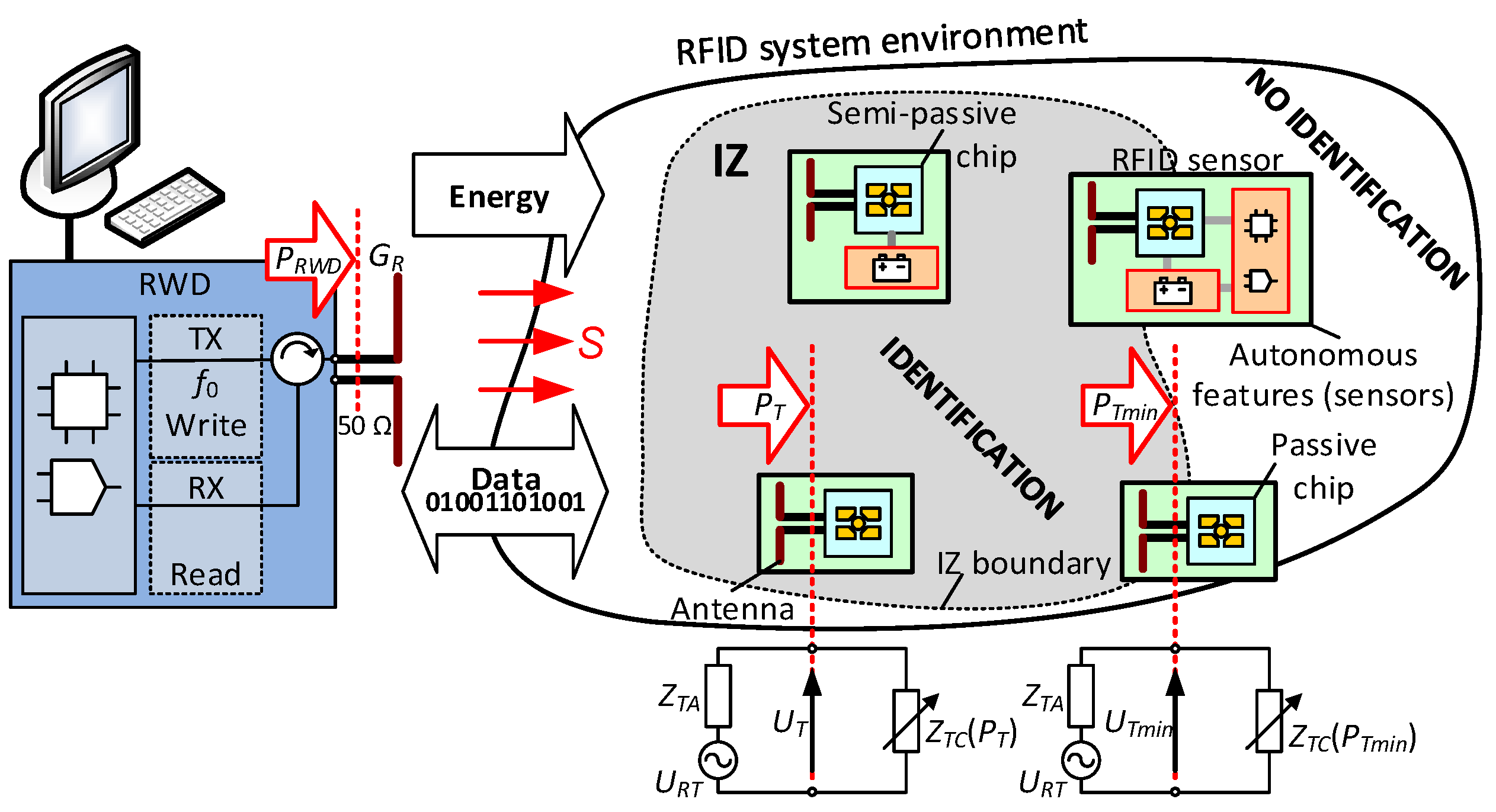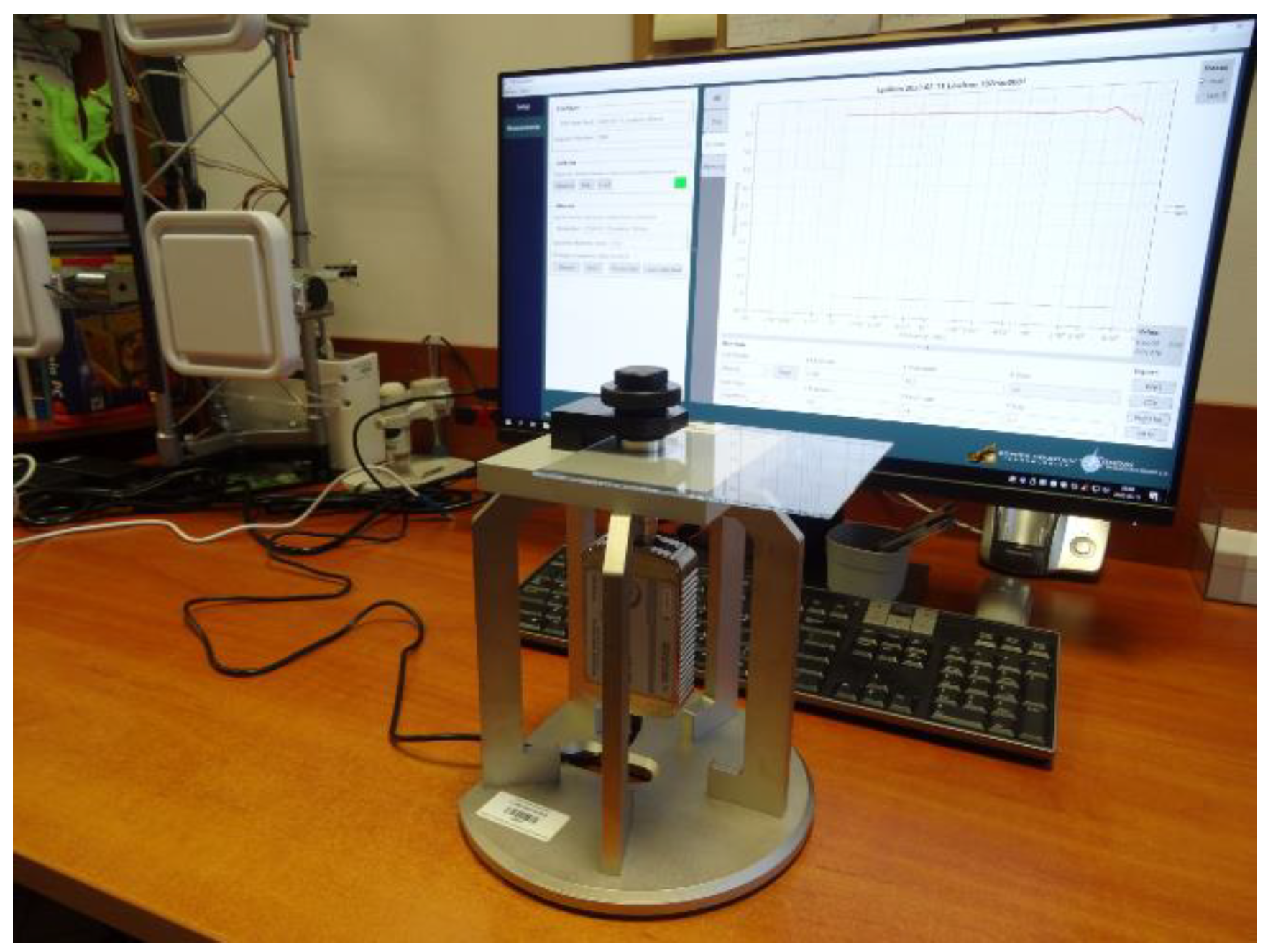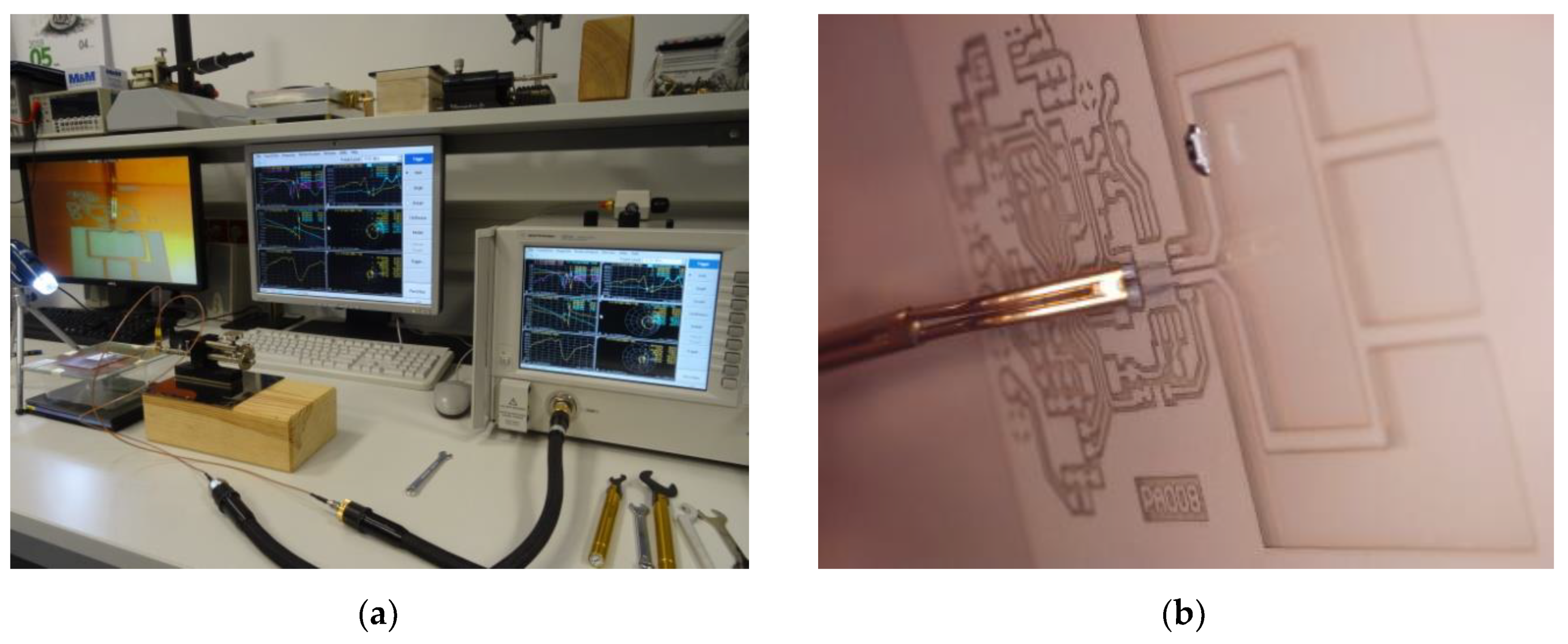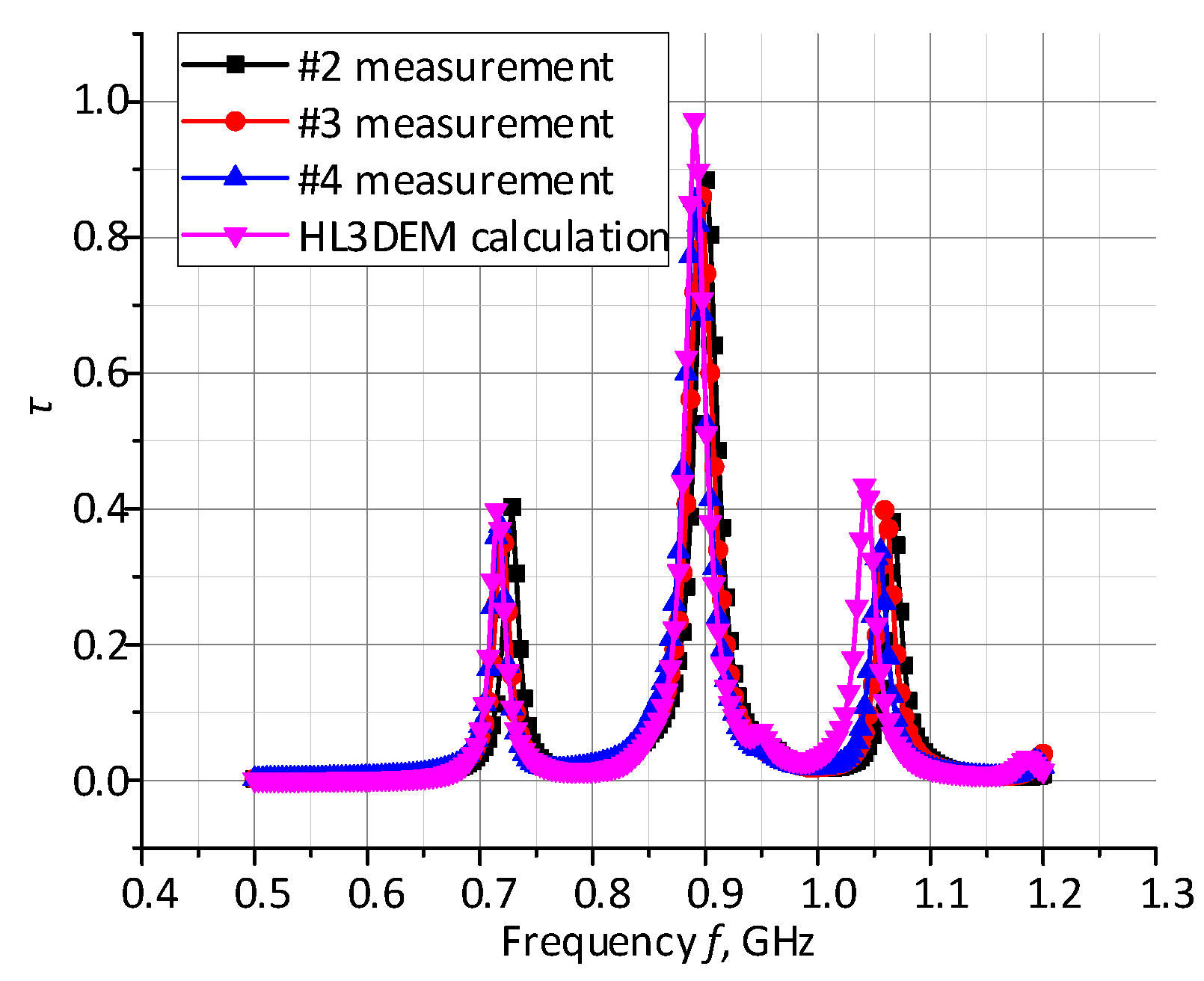Designing Antennas for RFID Sensors in Monitoring Parameters of Photovoltaic Panels
Abstract
1. Introduction
1.1. RFID Technology
1.2. Princeples of Photovoltaic Panels
1.3. Issue of PV Panel Monitoring by RFID
1.4. Integration of Antennas and PV Panels
2. Materials and Methods
2.1. Impedance Matching
2.2. Selection of Antenna Construction for the Given Application
2.3. Antenna Design for RFID Sesnor Dedicated to PV Panels
2.4. Technology of Antenna Fabrication
3. Tests of Antenna
4. Conclusions
Author Contributions
Funding
Conflicts of Interest
References
- Finkenzeller, K. RFID Handbook—Fundamentals and Applications in Contactless Smart Cards. Radio Frequency Identification and Near-Field Communication, 3rd ed.; Wiley: Chichester, UK, 2010; p. 478. [Google Scholar]
- Ustundag, A. The Value of RFID. Benefits vs. Costs, 1st ed.; Springer: London, UK, 2013; p. 166. [Google Scholar]
- Diorio, C. New intelligence for RFID resurgence at item level. ID World Magazine, 2014; 44–45. [Google Scholar]
- IDTechEx. Continued growth as market for RFID exceeds $10bn milestone. ID World Magazine, 2015; 38–39. [Google Scholar]
- Traub, K. The GS1 EPCglobal Architecture Framework, GS1 a.i.s.b.l., Version 1.6. Available online: https://www.gs1.org/sites/default/files/docs/epc/architecture_1_6-framework-20140414.pdf (accessed on 12 July 2019).
- Bartneck, N.; Klaas, V.; Schönherr, H. Optimizing Processes with RFID and Auto ID: Fundamentals, Problems and Solutions, Example Applications; Publicis Publishing: Erlangen, Germany, 2009; p. 256. [Google Scholar]
- Giusto, D.; Iera, A.; Morabito, G.; Atzori, L. The Internet of Things. In Proceedings of the 20th Tyrrhenian Workshop on Digital Communications, Sardinia, Italy, 2–4 September 2009; Springer: New York, NY, USA, 2010; p. 442. [Google Scholar]
- Das, R. RFID Forecasts, Players and Opportunities 2019–2029, Report, IDTechEx, 2019. Available online: www.idtechex.com (accessed on 21 January 2019).
- Jankowski-Mihułowicz, P.; Lichoń, W.; Węglarski, M. A Procedure for validating impedance parameters of HF/UHF RFID transponder antennas. In Methods and Techniques of Signal Processing in Physical Measurements; Hanus, R., Mazur, D., Kreischer, C., Eds.; MSM2018, Lecture Notes in Electrical Engineering; Springer: Cham, Switzerland, 2019; Volume 548, pp. 101–118. [Google Scholar] [CrossRef]
- Jankowski-Mihułowicz, P.; Węglarski, M. Determination of passive and semi-passive chip parameters required for synthesis of interrogation zone in UHF RFID systems. Electron. Electr. Eng. 2014, 20, 65–73. [Google Scholar] [CrossRef]
- ISO/IEC 18000-63. Information Technology—Radio Frequency Identification for Item Management—Part 63: Parameters for Air Interface communications at 860 MHz to 960 MHz Type C, 2nd ed.; VDC Verlag: Berlin, Germany, 2015. [Google Scholar]
- Jankowski-Mihułowicz, P.; Węglarski, M. Interrogation Zone Determination in HF RFID Systems with Multiplexed Antennas. Arch. Electr. Eng. 2015, 64/3, 459–470. [Google Scholar] [CrossRef]
- Ukkonen, L.; Sydanheimo, L.; Kivikoski, M. Read Range Performance Comparison of Compact Reader Antennas for a Handheld UHF RFID Reader. In Proceedings of the 2007 IEEE International Conference on RFID, Grapevine, TX, USA, 26–28 March 2007; Volume 45, pp. 24–31. [Google Scholar] [CrossRef]
- Dobkin, D.M. The RF in RFID: UHF RFID in Practice, 2nd ed.; Newnes: Oxford, UK, 2012; p. 540. [Google Scholar]
- Boaventura, A.J.S.; Carvalho, N.B. Extending Reading Range of Commercial RFID Readers. IEEE Trans. Microwave Theory Tech. 2013, 61, 633–640. [Google Scholar] [CrossRef]
- Hassan, M.; Ali, M.; Aktas, E. Radio Frequency Identification (RFID) Technologies for Locating Warehouse Resources: A Conceptual Framework. In Proceedings of the 2012 Smart SysTech European Conference on Smart Objects, Systems and Technologies, Osnabrück, Germany, 12–13 June 2012; pp. 1–20. [Google Scholar]
- Jankowski-Mihułowicz, P.; Węglarski, M.; Pitera, G.; Kawalec, D.; Lichoń, W. Development board of the autonomous semi-passive RFID transponder. Bull. Pol. Acad. Sci. Tech. Sci. 2016, 64, 647–654. [Google Scholar] [CrossRef]
- Abad, E.; Mazzolai, B.; Juarros, A.; Gómez, D.; Mondini, A.; Sayhan, I.; Krenkow, A.; Becker, T. Fabrication process for a flexible tag microlab, In Smart Sensors, Actuators, and MEMS III. In Proceedings of the Microtechnologies for the New Millennium, Gran Canaria, Spain, 2–4 May 2007; Becker, T., Cane, C., Barker, N.S., Eds.; SPIE: Bellingham, WA, USA, 2007; p. 6589. [Google Scholar] [CrossRef]
- Electronic Communication Commitee CEPT ECC: ERC Recommendation 70-03, Relating to the Use of Short Range Devices (SRD). Available online: https://www.ecodocdb.dk/download/25c41779-cd6e/Rec7003e.pdf (accessed on 11 February 2020).
- Luque, A.; Hegedus, S. Handbook of Photovoltaic Science and Engineering, 1st ed.; John Wiley & Sons Ltd.: Chichester, West Sussex, UK, 2003; p. 1138. [Google Scholar]
- Takruri, M.; Farhat, M.; Barambones, O.; Ramos-Hernanz, J.A.; Turkieh, M.J.; Badawi, M.; AlZoubi, H.; Sakur, M.A. Maximum Power Point Tracking of PV System Based on Machine Learning. Energies 2020, 13, 692. [Google Scholar] [CrossRef]
- Merenda, M.; Iero, D.; Carotenuto, R.; Corte, F.G.D. Simple and Low-Cost Photovoltaic Module Emulator. Electronics 2019, 8, 1445. [Google Scholar] [CrossRef]
- Suntio, T.; Kuperman, A. Maximum Perturbation Step Size in MPP-Tracking Control for Ensuring Predicted PV Power Settling Behavior. Energies 2019, 12, 3984. [Google Scholar] [CrossRef]
- Islam, H.; Mekhilef, S.; Shah, N.B.M.; Soon, T.K.; Seyedmahmousian, M.; Horan, B.; Stojcevski, A. Performance Evaluation of Maximum Power Point Tracking Approaches and Photovoltaic Systems. Energies 2018, 11, 365. [Google Scholar] [CrossRef]
- Hu, T.; Zheng, M.; Tan, J.; Zhu, L.; Miao, W. Intelligent photovoltaic monitoring based on solar irradiance big data and wireless sensor networks. Ad Hoc Netw. 2015, 35, 127–136. [Google Scholar] [CrossRef]
- Madeti, S.R.; Singh, S.N. Online fault detection and the economic analysis of grid-connected photovoltaic systems. Energy 2017, 134, 121–135. [Google Scholar] [CrossRef]
- Węglarski, M.; Jankowski-Mihułowicz, P. Factors Affecting the Synthesis of Autonomous Sensors with RFID Interface. Sensors 2019, 19, 4392. [Google Scholar] [CrossRef] [PubMed]
- Węglarski, M.; Jankowski-Mihułowicz, P.; Pitera, G.; Jurków, D.; Dorczyński, M. LTCC Flow Sensor with RFID Interface. Sensors 2020, 20, 268. [Google Scholar] [CrossRef]
- GS1 EPCglobal. EPC Radio-Frequency Identity Protocols Generation-2 UHF RFID; Specification for RFID Air Interface Protocol for Communications at 860 MHz–960 MHz, ver. 2.1; EPCglobal: Brussels, Belgium, 2018. [Google Scholar]
- ETSI EN 302 208. Radio Frequency Identification Equipment Operating in the Band 865 MHz to 868 MHz with Power Levels up to 2 W and in the Band 915 MHz to 921 MHz with Power Levels up to 4 W; ETSI: Sophia-Antipolis, France, 2016. [Google Scholar]
- Jankowski-Mihułowicz, P.; Lichoń, W.; Pitera, G.; Węglarski, M. Determination of the material relative permittivity in the UHF band by using T and modified ring resonators. Int. J. Electron. Telecommun. 2016, 62, 129–134. [Google Scholar] [CrossRef][Green Version]
- Lu, J.H.; Chang, B.S. Planar Compact Square-Ring Tag Antenna With Circular Polarization for UHF RFID Applications. IEEE Trans. Antennas Propag. 2017, 65/2, 432–441. [Google Scholar] [CrossRef]
- Griffin, J.D.; Durgin, G.D. Complete Link Budgets for Backscatter-Radio and RFID Systems. IEEE Antennas Propag. Mag. 2009, 51, 11–25. [Google Scholar] [CrossRef]
- Liu, Q.; Li, H.; Yu, Y. A Versatile Flexible UHF RFID Tag for Glass Bottle Labelling in Self-Service Stores. IEEE Access. 2018, 6, 59065–59073. [Google Scholar] [CrossRef]
- Ons, M.J.R. Integration of Antennas and Solar Cells for Autonomous Communication Systems. Ph.D. Thesis, Technological University Dublin, Dublin, Ireland, 2010. [Google Scholar] [CrossRef]
- Pan, T.; Zhang, S.; He, S. Compact RFID Tag Antenna With Circular Polarization and Embedded Feed Network for Metallic Objects. IEEE Antennas Wirel. Propag. Lett. 2014, 13, 1271–1274. [Google Scholar] [CrossRef]
- Lukas, I.J.; Qing, X.; Chen, Z.N.; Alphones, A. UHF omnidirectional bent dipole antenna for item-level RFID applications. In Proceedings of the IEEE Antennas and Propagation Society International Symposium, San Diego, CA, USA, 5–11 July 2008; pp. 1–4. [Google Scholar] [CrossRef]
- Kaiwen, K.T.; Qing, X.; Goh, C.K.; Zhu, L. A UHF omni-directional RFID antenna. In Proceedings of the IEEE Antennas and Propagation Society International Symposium, Toronto, ON, Canada, 11–17 July 2010; pp. 1–4. [Google Scholar] [CrossRef]
- Phatarachaisakul, T.; Pumpoung, T.; Phongcharoenpanich, C. Dual-band RFID tag antenna with EBG for glass objects. In Proceedings of the IEEE 4th Asia-Pacific Conference on Antennas and Propagation, Kuta, Indonesia, 30 June–3 July 2015; pp. 199–200. [Google Scholar] [CrossRef]
- Lu, J.H.; Wu, J.J. UHF band RFID tag antenna mounted on glass objects. In Proceedings of the IEEE Asia Pacific Microwave Conference, Singapore, 7–10 December 2009; pp. 622–624. [Google Scholar] [CrossRef]
- Lin, Y.; Yeh, S.; Chen, H.; Chang, S. Design of an Omnidirectional Polarized RFID Tag Antenna for Safety Glass Applications. IEEE Trans. Antennas Propag. 2012, 60, 4530–4537. [Google Scholar] [CrossRef]
- Pantoja, J.J.; Parra, L.A.P.; Neira, E.; Vega, F. On the backscattering from RFID tags installed on vehicular glasses. In Proceedings of the IEEE International Symposium on Antennas and Propagation & USNC/URSI National Radio Science Meeting, San Diego, CA, USA, 9–14 July 2017; pp. 2517–2518. [Google Scholar] [CrossRef]
- Marrocco, G. The art of UHF RFID antenna design: Impedance-matching and size-reduction techniques. IEEE Antennas Propag. Mag. 2008, 50, 66–79. [Google Scholar] [CrossRef]
- AMS. SL900A EPC Class 3 Sensory Tag Chip—For Automatic Data Logging; Datasheet; AMS: AG, Premstaetten, Austria, 2018; Available online: http://ams.com (accessed on 10 February 2020).
- Ramirez, R.A.; Rojas-Nastrucci, E.A.; Weller, T.M. UHF RFID tags for On-/Off-metal applications fabricated using additive manufacturing. IEEE Antennas Wirel. Propag. Lett. 2017, 16, 1635–1638. [Google Scholar] [CrossRef]
- Sohrab, A.P.; Huang, Y.; Hussein, M.N.; Carter, P. A hybrid UHF RFID tag robust to host material. IEEE J. Radio Freq. Identif. 2017, 1, 163–169. [Google Scholar] [CrossRef]
- Rardin, T.E.; Renmei, X. Printing Processes Used to Manufacture Photovoltaic Solar Cells. J. Technol. Stud. 2012, 37, 1–10. [Google Scholar] [CrossRef][Green Version]












| Specimen Geometry, Dimensions, mm | |||||||
|---|---|---|---|---|---|---|---|
| L1 | L2 | L3 | L4 | W1 | W2 | W3 | H |
| 72.10 | 26.80 | 13.90 | 11.90 | 98.80 | 30.00 | 19.70 | 1.00 |
| Frequency, MHz | ZTC, Ω | ZTC, Ω |
|---|---|---|
| Passive Mode | Semipassive Mode | |
| Ubat = 0 V | Ubat = 1.5 V | |
| f0 = 866 | 14.9−j 342 | 14.7−j 338 |
| f0 = 900 | 14.9−j 342 | 14.4−j 316 |
| f0 = 915 | 15.3−j 313 | 14.9−j 309 |
| mean value => 860–960 | 14.5−j 316 | 14.0−j 314 |
© 2020 by the authors. Licensee MDPI, Basel, Switzerland. This article is an open access article distributed under the terms and conditions of the Creative Commons Attribution (CC BY) license (http://creativecommons.org/licenses/by/4.0/).
Share and Cite
Węglarski, M.; Jankowski-Mihułowicz, P.; Chamera, M.; Dziedzic, J.; Kwaśnicki, P. Designing Antennas for RFID Sensors in Monitoring Parameters of Photovoltaic Panels. Micromachines 2020, 11, 420. https://doi.org/10.3390/mi11040420
Węglarski M, Jankowski-Mihułowicz P, Chamera M, Dziedzic J, Kwaśnicki P. Designing Antennas for RFID Sensors in Monitoring Parameters of Photovoltaic Panels. Micromachines. 2020; 11(4):420. https://doi.org/10.3390/mi11040420
Chicago/Turabian StyleWęglarski, Mariusz, Piotr Jankowski-Mihułowicz, Mateusz Chamera, Justyna Dziedzic, and Paweł Kwaśnicki. 2020. "Designing Antennas for RFID Sensors in Monitoring Parameters of Photovoltaic Panels" Micromachines 11, no. 4: 420. https://doi.org/10.3390/mi11040420
APA StyleWęglarski, M., Jankowski-Mihułowicz, P., Chamera, M., Dziedzic, J., & Kwaśnicki, P. (2020). Designing Antennas for RFID Sensors in Monitoring Parameters of Photovoltaic Panels. Micromachines, 11(4), 420. https://doi.org/10.3390/mi11040420






